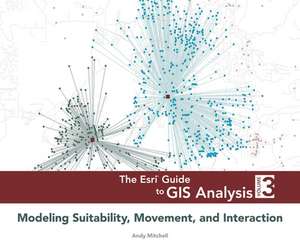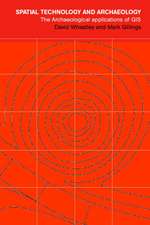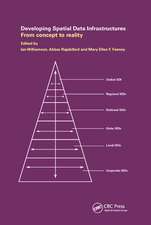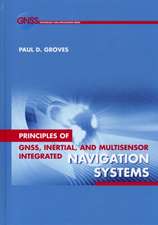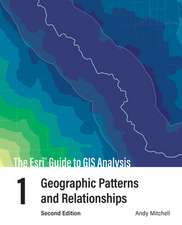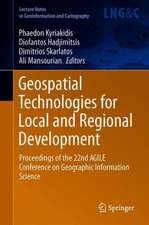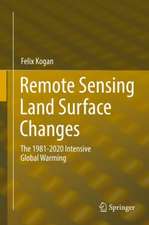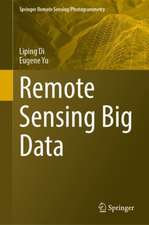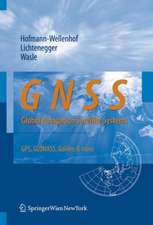The ESRI Guide to GIS Analysis, Volume 3: Modeling Suitability, Movement, and Interaction: The ESRI Guide to GIS Analysis
Autor Andy Mitchellen Limba Engleză Paperback – 30 iun 2012
The Esri Guide to GIS Analysis, Volume 3: Modeling Suitability, Movement, and Interaction describes practical applications of modeling concepts in a geographic information system (GIS). This book shows readers how they can explore spatial interaction, site selection, routing, and scheduling, and explains how to best interpret the results of the analysis. With full-color maps and illustrations and sample applications, this book will help students studying GIS and professional GIS analysts better use models to evaluate locations and analyze movement.
Preț: 371.24 lei
Nou
Puncte Express: 557
Preț estimativ în valută:
71.04€ • 74.51$ • 59.14£
71.04€ • 74.51$ • 59.14£
Carte disponibilă
Livrare economică 11-25 martie
Preluare comenzi: 021 569.72.76
Specificații
ISBN-13: 9781589483057
ISBN-10: 1589483057
Pagini: 419
Ilustrații: 700
Dimensiuni: 230 x 192 x 28 mm
Greutate: 0.98 kg
Editura: Esri Press
Seria The ESRI Guide to GIS Analysis
ISBN-10: 1589483057
Pagini: 419
Ilustrații: 700
Dimensiuni: 230 x 192 x 28 mm
Greutate: 0.98 kg
Editura: Esri Press
Seria The ESRI Guide to GIS Analysis
Cuprins
Chapter 1 Introducing GIS modeling
The GIS modeling process
Define the goal of the analysis
Define the criteria
Collect the data
Run the model
Verify the results
Modify and re-run the model
Document the analysis
Display and apply the results
Modeling and GIS data
Spatial data types
Attribute data
Accounting for spatial bias
Geographic scale
Data quality
References and further reading
Chapter 2 Finding suitable locations
Designing a Boolean suitability model
Evaluating locations
Identifying potential locations
References and further reading
Chapter 3 Rating suitable locations
Designing a suitability model to rate locations
Rating locations using weighted overlay
Rating locations using fuzzy overlay
References and further reading
Chapter 4 Predicting favorable locations
Designing a model to predict favorable locations
Predicting using known occurrences
References and further reading
Chapter 5 Modeling paths and corridors
Designing a path model
Modeling a path over a network
Modeling an overland path
References and further reading
Chapter 6 Modeling interaction
Designing a model of interaction
Allocating demand to facilities
Modeling travel to facilities
References and further reading
The GIS modeling process
Define the goal of the analysis
Define the criteria
Collect the data
Run the model
Verify the results
Modify and re-run the model
Document the analysis
Display and apply the results
Modeling and GIS data
Spatial data types
Attribute data
Accounting for spatial bias
Geographic scale
Data quality
References and further reading
Chapter 2 Finding suitable locations
Designing a Boolean suitability model
Evaluating locations
Identifying potential locations
References and further reading
Chapter 3 Rating suitable locations
Designing a suitability model to rate locations
Rating locations using weighted overlay
Rating locations using fuzzy overlay
References and further reading
Chapter 4 Predicting favorable locations
Designing a model to predict favorable locations
Predicting using known occurrences
References and further reading
Chapter 5 Modeling paths and corridors
Designing a path model
Modeling a path over a network
Modeling an overland path
References and further reading
Chapter 6 Modeling interaction
Designing a model of interaction
Allocating demand to facilities
Modeling travel to facilities
References and further reading
Notă biografică
Andy Mitchell is a writer at Esri. He is the author of ESRI Guide to GIS Analysis, Volume 1: Geographic Patterns and Relationships (Esri Press 1999) and ESRI Guide to GIS Analysis, Volume 2: Spatial Measurements and Statistics (Esri Press 2005).
Descriere
This guide describes practical applications of modeling concepts in a geographic information system. Readers can explore questions involving spatial interaction, site selection, routing, and scheduling, and how to interpret results. Complete with full-color maps and illustrations.
